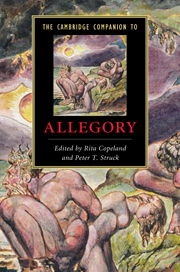Book contents
- Frontmatter
- Introduction
- Part I: Ancient foundations
- Part II: Philosophy, theology, and poetry 200 to 1200
- Part III: Literary allegory: philosophy and figuration
- 8 Allegory in the Roman de la Rose
- 9 Dante and allegory
- 10 Medieval secular allegory: French and English
- 11 Medieval religious allegory: French and English
- 12 Renaissance allegory from Petrarch to Spenser
- 13 Protestant allegory
- 14 Allegorical drama
- Part IV: The fall and rise of allegory
- Further reading
- Index
9 - Dante and allegory
from Part III: - Literary allegory: philosophy and figuration
Published online by Cambridge University Press: 28 January 2011
- Frontmatter
- Introduction
- Part I: Ancient foundations
- Part II: Philosophy, theology, and poetry 200 to 1200
- Part III: Literary allegory: philosophy and figuration
- 8 Allegory in the Roman de la Rose
- 9 Dante and allegory
- 10 Medieval secular allegory: French and English
- 11 Medieval religious allegory: French and English
- 12 Renaissance allegory from Petrarch to Spenser
- 13 Protestant allegory
- 14 Allegorical drama
- Part IV: The fall and rise of allegory
- Further reading
- Index
Summary
Since the seminal work of Charles Singleton in the 1950s, the subject of allegory has been at the controversial heart of Dante scholarship. The debate focuses on the Commedia and in particular on the question of whether Dante is there writing an allegory “of theologians,” that is, an imitation of the fourfold model of Scriptural signification, or not. Around this central question several others are arrayed. Is the “letter” of the “holy poem” to be taken as “true” like that of the Bible or as a “beautiful lie”? If the Commedia is modeled on the Bible, does it include all or some of the three allegorical senses (allegorical or Christological; moral or tropological; anagogical or eschatological) attributed to Scripture in the exegetical tradition? Is it more appropriate to talk about the Commedia in terms of allegory per se or rather in those of the typological ordering of God's two books - the Bible and creation as a whole - sub specie aeternitatis, which provides the ontological and epistemological basis out of which the fourfold scheme is developed? Most of what has been written - far more than can be summarized here - has been aimed at determining the Commedia's intrinsic mode of signification and has consistently begged the question of how Dante might have come to displace into the domain of lay vernacular poetry an exegetical practice designed for exclusive application to Holy Scripture, and what might the wider significance of such an extraordinary displacement have been.
- Type
- Chapter
- Information
- The Cambridge Companion to Allegory , pp. 128 - 135Publisher: Cambridge University PressPrint publication year: 2010
- 4
- Cited by

